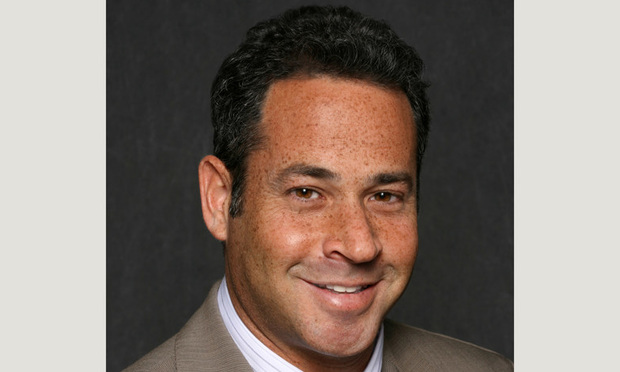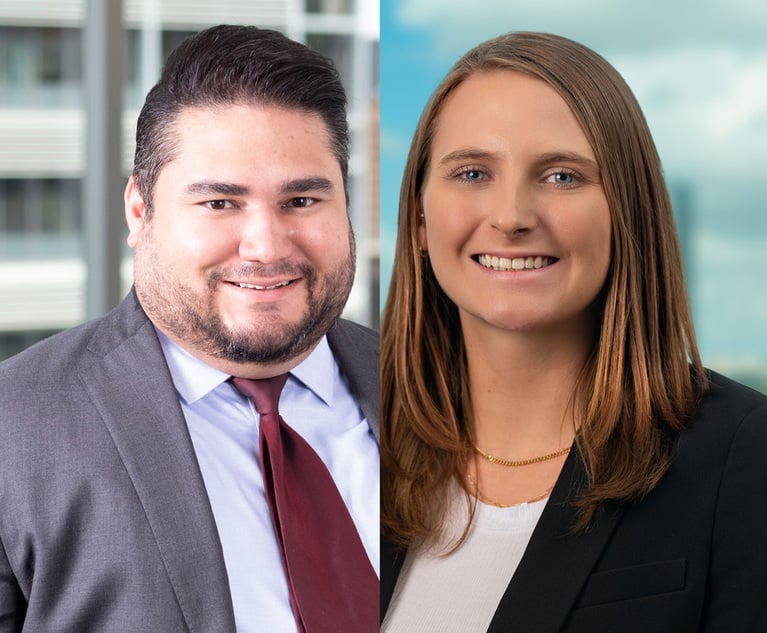Opportunity Zones: Real Estate, Land Development and Other Considerations
Much has been written lately on the Opportunity Zone program. Created in the Tax Cuts and Jobs Act of 2017, the program essentially allows the creation of funds to cultivate new businesses, invest capital to expand existing businesses or develop real estate.
January 30, 2019 at 09:04 AM
5 minute read
 David E. Sacks, partner with Pathman Lewis in Miami.
David E. Sacks, partner with Pathman Lewis in Miami.
Much has been written lately on the Opportunity Zone program. Created in the Tax Cuts and Jobs Act of 2017, the program essentially allows the creation of funds to cultivate new businesses, invest capital to expand existing businesses or develop real estate. Such benefits include, deferred capital gains, a reduced cost basis for capital gains and tax-free appreciation for investors all in designated economically distressed communities referred to pursuant to the new law as Qualified Opportunity Zones. The idea behind Opportunity Zones is to spur economic activity in places that are currently distressed within an Opportunity Zone.
However, there seems to be the absence of any real estate, land development or environmental cleanup benefits beyond the tax benefits briefly mentioned that is associated with the Opportunity Zone program.
Background and Initial Investment Considerations
There are 427 Opportunity Zones in Florida including 68 in Miami-Dade County, 30 in Broward County and 35 in Palm Beach County that have been deemed as economically distressed as designated by Gov. Rick Scott. There are a number of tools allowing the developer or investor to search for Qualified Opportunity Zones.
To invest in a Qualified Opportunity Zone, individuals or companies must invest in a Qualified Opportunity Fund including limited liability companies, corporations or partnerships. The fund must then purchase or invest in an existing business, or acquire, develop or invest in land or buildings in an Opportunity Zone. However, a fund cannot simply buy an existing property in an Opportunity Zone—it must make a substantial improvement of an Opportunity Zone property within a certain amount of time of closing on the qualified property to remain eligible for the fully panoply of benefits. The requirement that the property be substantially improved would likely involve land use, development and potentially environmental considerations as part of a buyer's due diligence analysis of the property.
Real Estate Pricing Negotiations
A seller looking to sell real estate in an Opportunity Zone may find that the tax incentives can make potential buyers' economics and purchase price easier to work out, and may lead to more offers for the property. Additionally another benefit to keep in mind is that if a company located elsewhere needs, for instance, industrial space, it may consider building in an Opportunity Zone through a properly structured fund. Long-term investors with stable cash flow are good candidates for these types of investments.
Potential Local Economic and Regulatory Benefits
Given the passage of the Tax Cuts and Jobs Act and the ostensible public purpose for revitalizing property and encouraging investment within any of Florida's Opportunity Zones, it may be possible for a developer owning property within an Opportunity Zone to bootstrap the public benefits of the act with local, state or federal economic development benefit programs. One practical course of action is to work with the respective administration(s) having jurisdiction within an Opportunity Zone such as the director of economic development for the availability of grants or other funds. For example, an environmentally contaminated property located within an Opportunity Zone may also be eligible for the economic development benefits associated with Florida's Brownfield Redevelopment Act. Often, properties located within an Opportunity Zone are also potential Brownfield sites which are defined as properties having contamination or the “stigma” of contamination, remain undeveloped. Therefore, potential available economic funds at the various governmental levels should be evaluated to further increase the return on investment for properties located within Opportunity Zones.
Similarly, land use and zoning regulatory incentives may be permissible at the municipal and other levels of government. For example, cities may choose to enter into a development agreement with the city or seek legislation expediting permit review, relaxing certain development requirements, or provide certain value added development rights in connection with a given properties location within an Opportunity Zone.
Conclusion
Most importantly, as with any investment, the underlying fundamentals of the investment must make sense for the developer or investor and not just from a tax perspective. Threshold issues must first be analyzed including whether it makes sound business sense to hold a property within the Opportunity Zone for the five, seven or 10-plus years the law and regulations known to date require. Further, an evaluation of the risk for a certain property within an Opportunity Zone in the event the asset does not increase in value. Finally, seeking legal and accounting advice to structure the investment properly, as the interplay between the economics and statute can quickly become complicated.
David E. Sacks is a partner at Pathman Lewis in Miami. He practices real estate, land use, zoning, and environmental law. He can be reached at [email protected].
This content has been archived. It is available through our partners, LexisNexis® and Bloomberg Law.
To view this content, please continue to their sites.
Not a Lexis Subscriber?
Subscribe Now
Not a Bloomberg Law Subscriber?
Subscribe Now
NOT FOR REPRINT
© 2025 ALM Global, LLC, All Rights Reserved. Request academic re-use from www.copyright.com. All other uses, submit a request to [email protected]. For more information visit Asset & Logo Licensing.
You Might Like
View All

Leveraging the Power of Local Chambers of Commerce: A Second-Career Lawyer’s Guide to Building a Thriving Practice
5 minute read
CFPB Proposes Rule to Regulate Data Brokers Selling Sensitive Information
5 minute read
Essential Labor Shifts: Navigating Noncompetes, Workplace Politics and the AI Revolution
Trending Stories
- 1'A Death Sentence for TikTok'?: Litigators and Experts Weigh Impact of Potential Ban on Creators and Data Privacy
- 2Bribery Case Against Former Lt. Gov. Brian Benjamin Is Dropped
- 3‘Extremely Disturbing’: AI Firms Face Class Action by ‘Taskers’ Exposed to Traumatic Content
- 4State Appeals Court Revives BraunHagey Lawsuit Alleging $4.2M Unlawful Wire to China
- 5Invoking Trump, AG Bonta Reminds Lawyers of Duties to Noncitizens in Plea Dealing
Who Got The Work
J. Brugh Lower of Gibbons has entered an appearance for industrial equipment supplier Devco Corporation in a pending trademark infringement lawsuit. The suit, accusing the defendant of selling knock-off Graco products, was filed Dec. 18 in New Jersey District Court by Rivkin Radler on behalf of Graco Inc. and Graco Minnesota. The case, assigned to U.S. District Judge Zahid N. Quraishi, is 3:24-cv-11294, Graco Inc. et al v. Devco Corporation.
Who Got The Work
Rebecca Maller-Stein and Kent A. Yalowitz of Arnold & Porter Kaye Scholer have entered their appearances for Hanaco Venture Capital and its executives, Lior Prosor and David Frankel, in a pending securities lawsuit. The action, filed on Dec. 24 in New York Southern District Court by Zell, Aron & Co. on behalf of Goldeneye Advisors, accuses the defendants of negligently and fraudulently managing the plaintiff's $1 million investment. The case, assigned to U.S. District Judge Vernon S. Broderick, is 1:24-cv-09918, Goldeneye Advisors, LLC v. Hanaco Venture Capital, Ltd. et al.
Who Got The Work
Attorneys from A&O Shearman has stepped in as defense counsel for Toronto-Dominion Bank and other defendants in a pending securities class action. The suit, filed Dec. 11 in New York Southern District Court by Bleichmar Fonti & Auld, accuses the defendants of concealing the bank's 'pervasive' deficiencies in regards to its compliance with the Bank Secrecy Act and the quality of its anti-money laundering controls. The case, assigned to U.S. District Judge Arun Subramanian, is 1:24-cv-09445, Gonzalez v. The Toronto-Dominion Bank et al.
Who Got The Work
Crown Castle International, a Pennsylvania company providing shared communications infrastructure, has turned to Luke D. Wolf of Gordon Rees Scully Mansukhani to fend off a pending breach-of-contract lawsuit. The court action, filed Nov. 25 in Michigan Eastern District Court by Hooper Hathaway PC on behalf of The Town Residences LLC, accuses Crown Castle of failing to transfer approximately $30,000 in utility payments from T-Mobile in breach of a roof-top lease and assignment agreement. The case, assigned to U.S. District Judge Susan K. Declercq, is 2:24-cv-13131, The Town Residences LLC v. T-Mobile US, Inc. et al.
Who Got The Work
Wilfred P. Coronato and Daniel M. Schwartz of McCarter & English have stepped in as defense counsel to Electrolux Home Products Inc. in a pending product liability lawsuit. The court action, filed Nov. 26 in New York Eastern District Court by Poulos Lopiccolo PC and Nagel Rice LLP on behalf of David Stern, alleges that the defendant's refrigerators’ drawers and shelving repeatedly break and fall apart within months after purchase. The case, assigned to U.S. District Judge Joan M. Azrack, is 2:24-cv-08204, Stern v. Electrolux Home Products, Inc.
Featured Firms
Law Offices of Gary Martin Hays & Associates, P.C.
(470) 294-1674
Law Offices of Mark E. Salomone
(857) 444-6468
Smith & Hassler
(713) 739-1250






